6.7 Abwarten und Tee trinken

Guten Tag!
Zum Aufwärmen machen wir unseren Tagesminiplausch und eine Wiederholung.
Wiederholung
In the previous lesson, you learned about die kalte Mahlzeit . Let’s review what you have learned.
What foods do you remember from die kalte Mahlzeit? Write those food items that you remember in your written journal. Then answer the question, Isst du oft mittags oder abends kalt? Do you often eat a cold meal for lunch or dinner? Ja oder nein?
Lektionsüberblick
The idiomatic expression “Abwarten und Tee trinken” (wait and drink tea) is used when conveying that someone just have to be patient. The British are well-known for their tea time. The Germans have their equivalent, Teestunde, which occurs in the mid-afternoon and generally includes some baked goods. This is one of the different kinds of Zwischenmahlzeiten (the in-between meals) you can find in German. The Zwischenmahlzeit is another meal that has no unified tradition across the German and American spectrums. In this lesson, you will learn about a variety of German Zwischenmahlzeiten and compare your own habits and traditions to them. In the end, you will be able to 1) recognize names for various Zwischenmahlzeiten, 2) recognize food and drinks common to these meals, and 3) list what you typically consume in-between your other meals.
1) die Zwischenmahlzeiten
The most common Zwischenmahlzeit in Germany is Kaffeetrinken or Teestunde/Teetrinken in the mid-afternoon (around 16hr). Broadly speaking, Kaffeetrinken happens more in the south and Teestunde in the north. Funnily enough, you can hear people all over Germany refer to Kaffeetrinken even if tea – and not coffee – is being served! If you have been invited to Kaffee or Tee, you will generally be offered one or more baked goods with your drink.
The other kinds of Zwischenmahlzeiten are more typically rooted in specific settings and would be referred to in the US as snack times. For example, children will often have a Brotzeit or Vesper in school mid-morning, between breakfast and lunch. You may also find Brotzeit/Vesper on construction sites and in other settings, where the work begins early in the morning, making the time between breakfast and lunch long. The terms Brotzeit or Vesper are generally regional and consist of non-sweet food items like a belegtes Brötchen or Brot (a kind of sandwich made on a bread roll or bread with butter and cold cuts). Privately, people may also refer to these kinds of in-between meals with Brotzeit, Vesper, Imbiss or Snack. Imbiss can also refer to a stand where fast food and snacks are served.
Read through the information above carefully. Based on what you have read, complete the matching activity below.
Jetzt bist du dran!
2) Was man isst und trinkt
Was isst man zur Zwischenmahlzeit? What does one eat at snack time? Here are some ideas.
Jetzt bist du dran!
Listen again to the pronunciation of the words you chose. Then record yourself pronouncing them in your audio journal.
Hamburg im Blickpunkt

Das Hamburger Rathaus wurde zwischen 1886-1897 im Baustil Neorenaissance gebaut. Die Bau kostete damals 11 Millionen Goldmark (heute ca. EUR 80 Millionen). Das Gebäude ist fast so breit (111m) wie es hoch ist (112m). Die Fassade ist aus Granit und Sandstein und das Dach ist aus Kupfer. Das Rathaus hat 647 Räume und eine Grundfläche von 7.840m2.
The Hamburg City Hall was built between 1886 and 1897 in the Neo-Renaissance style. The construction cost 11 million Goldmarks at the time (today approx. EUR 80 million). The building is almost as wide (111m; 364ft) as it is tall (112m; 367ft). The façade is made of granite and sandstone, and the roof is made of copper. The city hall has 647 rooms and a floor area of 7,840m² (84,389ft2).
3) Ich esse/trinke…
Read and listen to the comic below. How would you respond to the question.
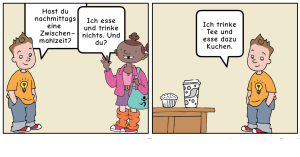
Some other ideas for responses.
| Ich trinke Tee und esse dazu Kekse. | |
| Ich trinke Kaffee und esse dazu nichts. |
Let’s practice.
Jetzt bist du dran!
Zum Schluß
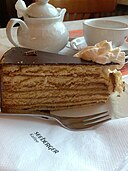 |
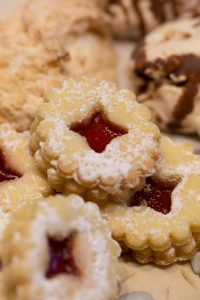 |
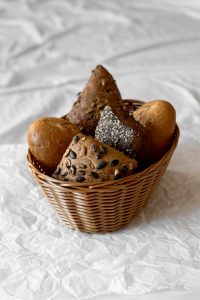 |
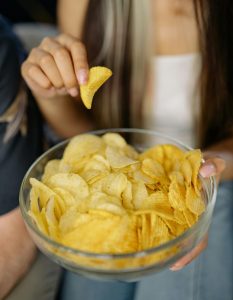 |
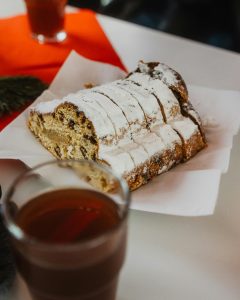 |

*As you conclude this lesson, don’t forget to check Canvas!*

Media Attributions
- 1010-1020 banner long large reduced
- Comic made at www.MakeBeliefsComix.com
- Photo of German Torte by Sven, CC BY 2.0 , via Wikimedia Commons
- Photo of Kekse by pexels-julius-weidenauer-296473414-14887822
- Photo of Brötchen by pexels-viktoriia-kondratiuk-458099300-18772824
- Photo of Kartoffelchips by pexels-yankrukov-9069287
- Photo of Tee und Kuchen by pexels-trueniko-19449856
- Private: confidence scale_large horizontal_updated

